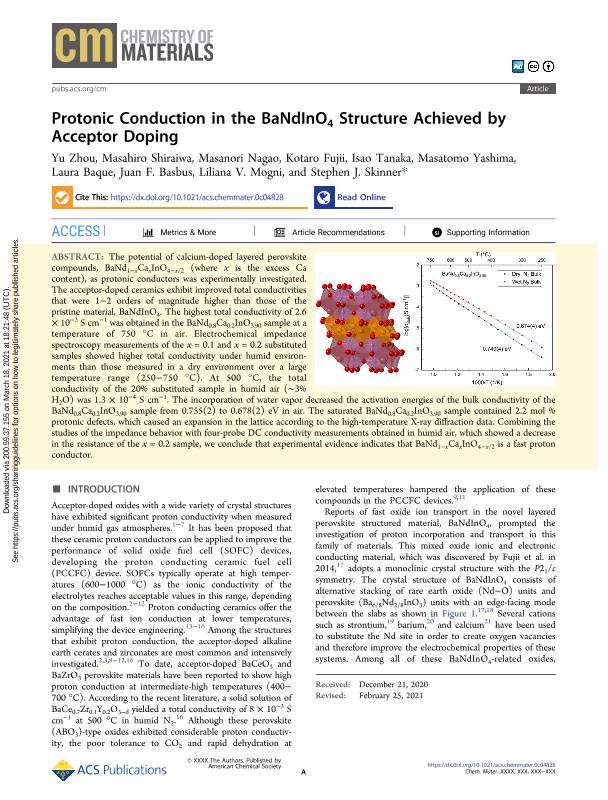Artículo
Protonic Conduction in the BaNdInO 4 Structure Achieved by Acceptor Doping
Zhou, Yu; Shiraiwa, Masahiro; Nagao, Masanori; Fujii, Kotaro; Tanaka, Isao; Yashima, Masatomo; Baque, Laura Cecilia ; Basbus, Juan Felipe
; Basbus, Juan Felipe ; Mogni, Liliana Verónica
; Mogni, Liliana Verónica ; Skinner, Stephen J.
; Skinner, Stephen J.
 ; Basbus, Juan Felipe
; Basbus, Juan Felipe ; Mogni, Liliana Verónica
; Mogni, Liliana Verónica ; Skinner, Stephen J.
; Skinner, Stephen J.
Fecha de publicación:
03/2021
Editorial:
American Chemical Society
Revista:
Chemistry Of Materials
ISSN:
0897-4756
Idioma:
Inglés
Tipo de recurso:
Artículo publicado
Clasificación temática:
Resumen
The potential of calcium-doped layered perovskite compounds, BaNd1-xCaxInO4-x/2 (where x is the excess Ca content), as protonic conductors was experimentally investigated. The acceptor-doped ceramics exhibit improved total conductivities that were 1-2 orders of magnitude higher than those of the pristine material, BaNdInO4. The highest total conductivity of 2.6 × 10-3 S cm-1 was obtained in the BaNd0.8Ca0.2InO3.90 sample at a temperature of 750 °C in air. Electrochemical impedance spectroscopy measurements of the x = 0.1 and x = 0.2 substituted samples showed higher total conductivity under humid environments than those measured in a dry environment over a large temperature range (250-750 °C). At 500 °C, the total conductivity of the 20% substituted sample in humid air (∼3% H2O) was 1.3 × 10-4 S cm-1. The incorporation of water vapor decreased the activation energies of the bulk conductivity of the BaNd0.8Ca0.2InO3.90 sample from 0.755(2) to 0.678(2) eV in air. The saturated BaNd0.8Ca0.2InO3.90 sample contained 2.2 mol % protonic defects, which caused an expansion in the lattice according to the high-temperature X-ray diffraction data. Combining the studies of the impedance behavior with four-probe DC conductivity measurements obtained in humid air, which showed a decrease in the resistance of the x = 0.2 sample, we conclude that experimental evidence indicates that BaNd1-xCaxInO4-x/2 is a fast proton conductor.
Palabras clave:
PROTON CONDUCTOR
,
OXIDE
,
CONDUCTIVITY
Archivos asociados
Licencia
Identificadores
Colecciones
Articulos (UE-INN - NODO BARILOCHE)
Articulos de UNIDAD EJECUTORA INSTITUTO DE NANOCIENCIA Y NANOTECNOLOGIA - NODO BARILOCHE
Articulos de UNIDAD EJECUTORA INSTITUTO DE NANOCIENCIA Y NANOTECNOLOGIA - NODO BARILOCHE
Citación
Zhou, Yu; Shiraiwa, Masahiro; Nagao, Masanori; Fujii, Kotaro; Tanaka, Isao; et al.; Protonic Conduction in the BaNdInO 4 Structure Achieved by Acceptor Doping; American Chemical Society; Chemistry Of Materials; 33; 6; 3-2021; 2139-2146
Compartir
Altmétricas



